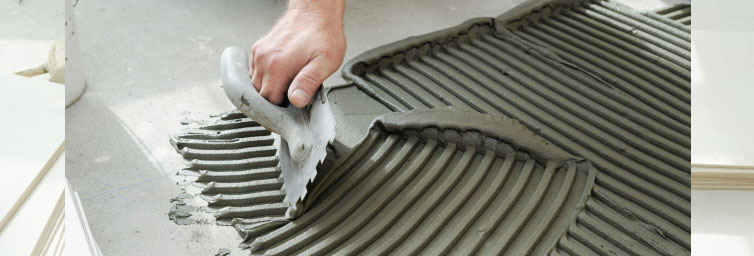Regardless of whether divider or floor tile, that tile needs to altogether Tile Adhesive to its base surface. Requests set on tile adhesive are both broad and steep. Tile adhesive is relied upon to hold the tile set up for quite a long time as well as for quite a long time—come what may. It should be not difficult to work with, and it should satisfactorily fill in holes between the tile and the substrate. It can’t fix excessively quickly: Else, you don’t have satisfactory working time. However, on the off chance that it fixes too leisurely, it consumes a huge chunk of time to get to the grouting stage.

Regardless of whether it’s a divider or floor tile, that tile needs to adhere to its substrate. The interest in tile adhesives is wide and steep. Tile adhesives are relied upon to hold tiles for quite a long time, however — without harm. It should be not difficult to work with and should fill in the holes between the block and the establishment. It can’t be relieved excessively fast: Else, you need more an ideal opportunity to work. In any case, in case it’s excessively sluggish, it consumes a large chunk of the day to get to the grouting stage.
Luckily, tile adhesives have developed to where they can effectively deal with those necessities. Picking the right block mortar can be significantly easier than you might suspect. Much of the time, the clearing application – where the tile is to be introduced – unmistakably decides the best grout alternative. Also, here and there the sort of block itself is the main consideration. Wall Plaster or wall tile adhesives can be applied straightforwardly from the can without blending. Decide the proper sort of scoop (V or square-score) and the right size (profundity of indents) for the kind of tile you are setting. Allude to the setting material bundle for suggestions.
Luckily, tile adhesives have advanced to where those requests can be effectively taken care of. Picking the right tile mortar can be much more straightforward than you may suspect. Much of the time, the tile application—where the tile is introduced—unmistakably decides the best mortar alternative. Also, once in a while, the sort of tile itself is a deciding element.
Thinset Tile Mortar
Thinset mortar is your default tile mortar for generally indoor and outside applications. Thinset is a mortar that is made of Portland cement, silica sand, and dampness holding specialists. Thinset tile mortar has a smooth, dangerous consistency, like mud. It is applied to the substrate with an indented scoop.
Standard and Pre-Blended Thinset
Standard thinset comes as a sacked powder that is blended in with water. The mortar starts setting whenever it is blended, so you need to go through the whole group or dispose of any overabundance.
Premixed thinset comes in huge tubs and is prepared to apply directly out of the bundle. Even though it is substantial to convey and more costly than a dry mortar blend, the simplicity and comfort of premixed thin-set mortar make it ideal for do-it-yourselfers.
Use premixed mortar for spaces like little restrooms, mudrooms, or utility rooms. On the off chance that you are managing various spaces, you might need to think about a dry blend to set aside cash.
Thinset Mortar Upsides and downsides
Thinset tile mortar gives an exceptionally solid bond and is impervious to dampness and shape development. Thinset is likewise heatproof, so it won’t lose its grasp in hot conditions. Since it is cementitious, thin-set makes thin-set is dimensionally steady—it won’t therapist or agreement.
Another benefit of this set is that it permits you to even out lopsided surfaces somewhat. You can’t even out uncontrollably out-of-level surfaces, however, you can connect holes and make up for slight level changes.
Since this set isn’t influenced by dampness, it is best for floor tile and any tile in wet regions, including shower floors, dividers, roofs and tub encompasses.
Since thin-set tile mortar might break, you might wish to blend it in with an extraordinary latex added substance to expand its solidarity.
Epoxy Tile Mortar
Epoxy tile mortar comes in a few separate parts that should be blended by the client just before use. Comparative with thin-set, epoxy mortar sets rapidly, permitting you to get to the grouting of the tile inside only a few hours. It is impenetrable to water, so it needn’t bother with any exceptional latex added substances, as does some thin-set.
Epoxy mortars function admirably for porcelain and art, just as for glass, stone, metal, mosaic, and rocks. Epoxy mortars can even be utilized for introducing elastic flooring or woodblock flooring.
Epoxy Tile Mortar Advantages and disadvantages
Epoxy-based mortars have high compressive strength and stick well to pitch sponsored stones. These mortars are easy to utilize and to keep up with. Mechanical strength is solid, so they hold the tile immovably set up and oppose pressure. Pigmented epoxy mortars don’t spill onto fired or porcelain tile. Epoxy mortars are impervious to a wide assortment of synthetic substances.
Temperatures should go somewhere in the range of 60 and 90 F for legitimate establishment. Hotter temperatures accelerate relieving time; cooler temperatures back it off. The establishment can be made on a soggy surface, however, new cement should be the solution for something like 28 days before the following tile.
On the drawback, epoxy mortar is more costly than thin-set and has a solid smell while it fixes. Furthermore, epoxy mortar sets rapidly. This can be a shortfall since it gives just a short window of time to make changes. Pot life for most epoxy tile mortars is around 45 minutes. After pot life lapses, the item is viewed as unusable.
Because of the trouble in blending and working with epoxy mortars, they will in general be utilized by proficient tile installers more than by do-it-yourselfers.
Epoxy-based grout has high compressive strength and a great grip on plastic substrates. These mortars are not difficult to utilize and keep up with. High mechanical strength, so they hold the tile solidly set up and oppose pressure. Pigmented epoxy grout doesn’t spill on clay or porcelain tiles. Epoxy grout is impervious to numerous synthetic compounds.
The temperature should be somewhere in the range of 60 and 90 F for legitimate establishment. Hotter temperatures accelerate relieving time; Lower temperature backs it off. The establishment should be possible on wet surfaces, however new cement should solution for somewhere around 28 days before the tile is applied.
Then again, epoxy grout is more costly than thin-set and has a solid smell while relieving. Moreover, epoxy grout sets rapidly. This can be a deficiency as it just gives a brief timeframe to make changes. Application time for most epoxy grout is around 45 minutes. After the finish of the existence of the pot, the item is considered unusable.
As a result of the trouble of blending and working with epoxy grouts, they will in general be utilized by proficient tile installers as opposed to do-it-yourselfers.
